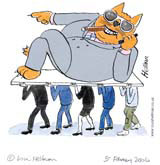Cat that got the cream
Non-executive directors may appear to get all the perks without the pain, but they can bring a fresh outlook to your design business, says Jim Davies.

Non-executive directors may appear to get all the perks without the pain, but they can bring a fresh outlook to your design business, says Jim Davies
Wouldn’t you just love to be a non-executive director? Swanning in past security at 11.30am. Waving cheerily to the troops as you shimmy towards your oak-panelled office. Smoking Havanas in your leather chair. Feeding the tropical fish. Flamboyantly signing a few cheques. Getting measured for a new Gieves & Hawkes suit and then strolling out for yet another lunch.
It’s the ultimate ‘fat cat’ job. All the power without the responsibility. The perks without the pain. The final pay-off for former politicians and diplomats, as they top up their pension before retiring to the Cotswolds.
At least, that’s what I used to think. But, recently, I’ve been fortunate enough to meet several who totally debunk the cliché. Perhaps surprisingly, they work in the design arena and are a growing breed. I needed some convincing at first, but it wasn’t so much their calm assurance, erudition and guru-like wisdom that won me over. It was the profound effect they had on those around them. Petty jealousies were put aside, verve and purpose were restored, and the good ship HMS Acme Design Group sailed happily again.
Appointing a non-executive director is a bit like George Harrison inviting Billy Preston to play keyboards on The Beatles’s penultimate album Let it Be. At this juncture, relations in the band were less than cordial. John and Paul were bitching like hairdressers and vying for artistic power. Yoko sat in the corner, brooding like a malevolent sprite.
But the introduction of a fifth musician changed the mood entirely. The boys were back on their best behaviour and wanted to impress. Billy became a welcome distraction and focus for positive change – for a while, anyway.
Let’s be honest, the design industry has a tendency to be insular and inward-looking. And individual companies, especially the smaller ones, are often too busy chasing their own tails. So, a fresh, broader perspective is a worthwhile investment. Non-executive directors see the bigger picture, offer an independent, objective point of view and can help bridge gaps in the board’s knowledge. You may be paying them well, but they are often part-time and, in the long-term, the benefits will usually outweigh the outlay.

Their position – one boot in the camp but the rest of them outside – gives them a special prerogative. If a board director asks another board director to take their feet off the desk, it’s a power struggle. If a non-executive does it, it’s a positive criticism, taken with good grace. And, while the board get on with running the business, the non-executive can consider other essential issues – mentoring, strategy, succession management, profile, recruitment policy and so on.
Of course, you must choose carefully. There needs to be trust and chemistry. You have to believe in each other. You could plump for someone with experience in another sector, who can offer lateral insight into your business. Or, more likely, a figurehead who’s already enjoyed success in the design or communications industry. It’s not that they necessarily know more, it’s just that they’ve often been there before you, and appreciate what to do in a given situation. And, of course, they’ve got a great, fat address book.
In a creative business, it’s easy to put too much emphasis on the creativity and too little on the business. But who knows? With a non-executive director on board, you might soon be chomping on a fine Havana cigar yourself.
-
Post a comment



